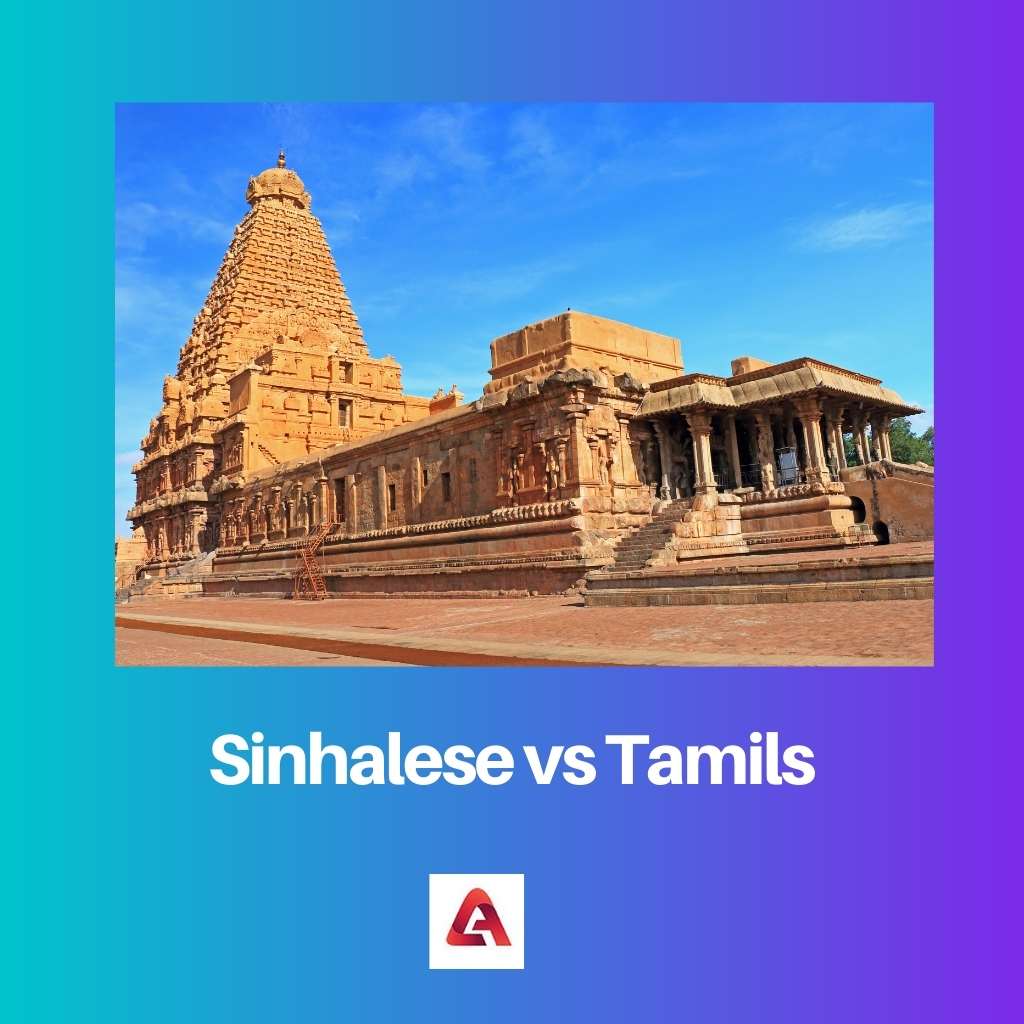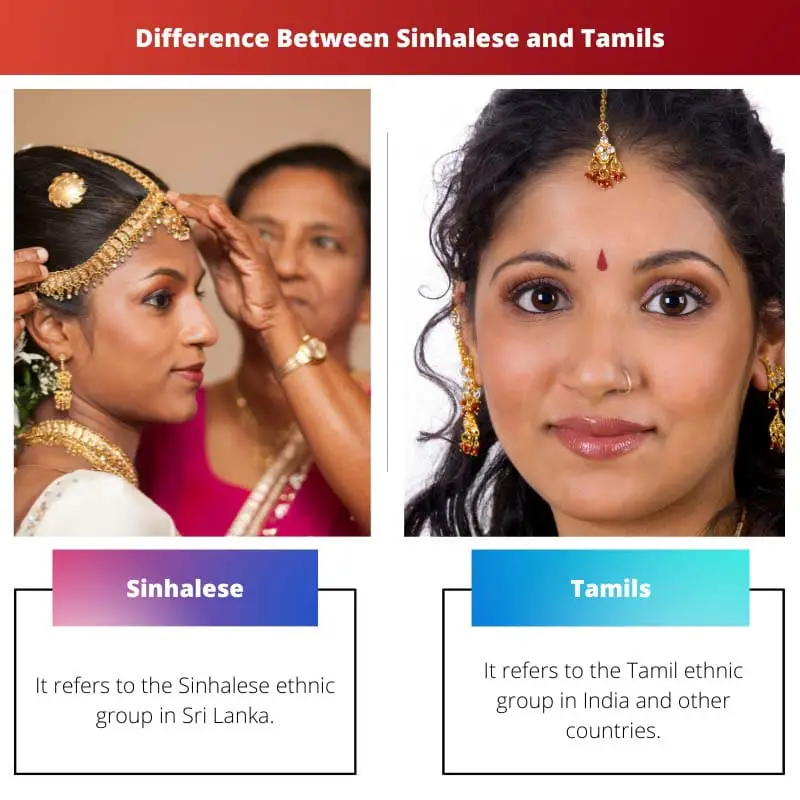It is easy to confuse people from different races and backgrounds. South Asia is a multicultural subcontinent with several religions, and races within the same geographical area.
It is one of the most diverse locations in the World. Tamils and Sinhalese are two different races that can be found in the South Asian region.
Key Takeaways
- Sinhalese people are the majority ethnic group in Sri Lanka, while Tamils form a significant minority.
- Sinhalese and Tamil belong to different linguistic families: Indo-Aryan and Dravidian.
- Both groups have unique cultural practices, traditions, and religions, contributing to Sri Lanka’s diverse cultural landscape.
Sinhalese vs Tamils
The difference between Sinhalese and Tamils is that most of the Tamil population resides in India, and the Sinhalese population belongs to Sri Lanka.
These two are distinct races from different countries, but they have a lot of shared aspects due to their geographical proximity.
There is a history of conflicts between these two communities.

The term Sinhalese refers to the ethnic group of people in Sri Lanka. They are the ethnic community comprising more than 80% of the Sri Lankan population.
Sinhalese people reside in the country’s South, East, and West parts. Most Sinhalese, around 70% of the population, are Theravada Buddhists.
Tamil refers to the language spoken by the Tamil community in the Indian state of Tamil Nadu.
The Tamil community is not limited to India, as they also constitute a minority population in other countries like Sri Lanka, Singapore, and Malaysia.
Tamils reside in the northern part of Sri Lanka.
Comparison Table
| Parameters of Comparison | Sinhalese | Tamils |
|---|---|---|
| Meaning | It refers to the Sinhalese ethnic group in Sri Lanka. | It refers to the Tamil ethnic group in India and other countries. |
| Religion | Theravada Buddhism is the major religion among the Sinhalese. | Hinduism is the primary religion among the Tamils, with other minority religions. |
| Language | Sinhala is the language spoken by them. | They speak the Tamil language. |
| Origins | There are claims that most Sinhalese are from the North Indian Bengal region. | Tamils belong to the Dravidian race and were the original inhabitants of India. |
| Population | Around 17 million people. | Around 76 million people are in different countries. |
What is Sinhalese?
The term Sinhalese refers to the ethnic group of people in Sri Lanka. The Sinhalese are the majority in Sri Lanka, constituting around 80% of the population.
The Sinhalese population resides in the country’s South, East, and West parts.
Most of the Sinhalese population follows the religion of Theravada Buddhism, and there is also a Christian minority.
There are around 17 million Sinhalese in Sri Lanka. They speak the Sinhala language, one of the official languages in Sri Lanka, and Tamil.
Since the independence of Sri Lanka, there has been discrimination against the Tamils.
Between the 1980s and 2009, this increased enormously as Sinhalese mobs carried out ethnic pogroms against the Tamils.
Sri Lankan Army played a significant role in initiating a civil war.
The word Sinhala also means Lion people. The origins of the Sinhala people can be traced back to West Bengal and South Indian states from the Hela tribes.
The ancient Pali language heavily influenced the Sinhala language spoken by them. The Buddhism religion that originated in India has several practitioners in Sri Lanka.
The genocide against Tamils ended in 2009, with more than 100,000 killed and 800,000 displaced as refugees.

What are Tamils?
The term Tamil refers to the language that is spoken by the Tamil community. The Tamil community is majorly found in the South Indian state of Tamil Nadu.
Besides India, the Tamil community has a significant presence in a few countries like Sri Lanka, Malaysia, Singapore, and Canada. The Tamils in Sri Lanka live in the Northern parts of the country.
Most of the Tamils are Hindus, but there are also other significant religions like Islam and Christianity.
There are around 76 million Tamils all over the World. The Tamil diaspora can be found in several countries, and Tamil is one of the official languages in Sri Lanka, Singapore, and Malaysia.
The Sinhalese government has historically discriminated against the Tamil community in Sri Lanka.
LTTE, a Tamil organization, fought for the right to self-determination of the Sri Lankan Tamils.
The Sri Lankan government opposed it, resulting in a civil war.
Around 2009, the violence ended with the killing of the LTTE leader Prabhakaran by the Sri Lankan Army.
Rape of Sri Lankan Tamil women, blasting hospitals in Tamil areas, and several more horrific crimes were committed by the Army.
It left around a million Tamils as refugees in other countries. Tamils continue to live in Sri Lanka with less influence and political representation.

Main Differences Between Sinhalese and Tamils
- Sinhalese refers to the ethnic group in Sri Lanka. Tamil refers to the Tamil community in India and other countries.
- Theravada Buddhism is the primary religion in Sri Lanka. Hinduism is the primary religion of the Tamils, along with Islam and Christian minorities.
- Sinhala is the language spoken by Sinhalese. Tamil is the language spoken by them.
- There are around 17 million Sinhalese in Sri Lanka and other countries. There are around 76 million Tamils in India and other countries.
- The origins of the Sinhalese can be traced to West Bengal in India. Tamils are the original inhabitants of the Indian subcontinent and, they belong to the Dravidian race.


This article delves into the intricacies of Sinhalese and Tamils, offering a nuanced understanding of their differences. It’s a noteworthy piece for those seeking insight into the historical and cultural aspects of these communities.
The article effectively highlights the discrimination and conflict faced by Tamils and Sinhalese, shedding light on the atrocities and struggles endured by both communities. It’s an eye-opening read on the impact of such conflicts.
This is a very well-researched article. It provides a comprehensive and detailed overview of the differences and similarities between Sinhalese and Tamils. The historical context is particularly interesting and helps to understand the complexities of the relationship between these two communities.
I completely agree. The article digs deep into the cultural, religious, and linguistic aspects of these two communities, shedding light on the root causes of conflict. It’s enlightening to see such an in-depth analysis.
No doubt, the article is a treasure trove of information about Sinhalese and Tamils. The reader gets a clear understanding of their origins, population, and religious practices, leaving little room for confusion or misunderstanding.
The conflict between Sinhalese and Tamils is a dark chapter in history, but this article does a commendable job of presenting the facts in an objective and informative manner. It’s crucial to have such knowledge to move towards healing and reconciliation.
The article’s emphasis on the historical context and the impact of discrimination and conflict serves as a valuable resource for understanding the complexities of the relationship between Sinhalese and Tamils. It’s a thought-provoking piece.
The comprehensive comparison table provides a clear breakdown of the differences between Sinhalese and Tamils, rendering complex information accessible to readers. This structured approach enhances the article’s quality.